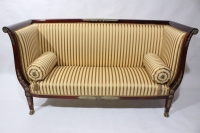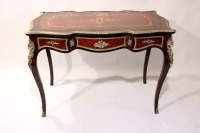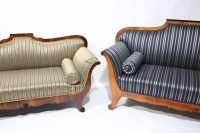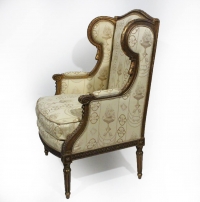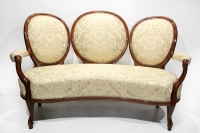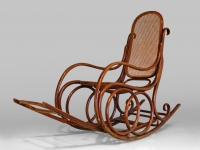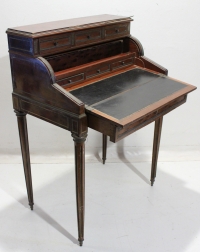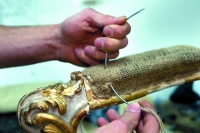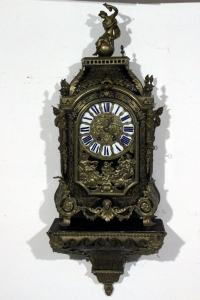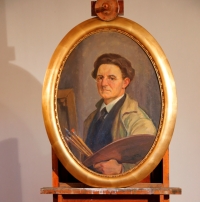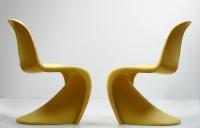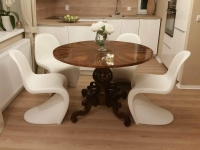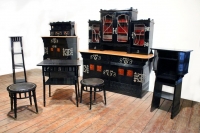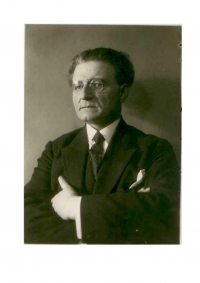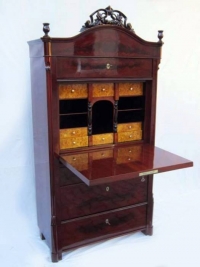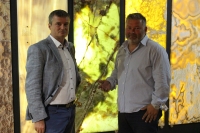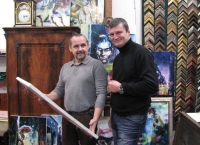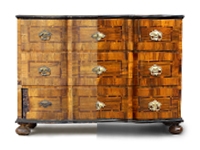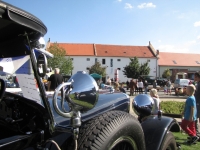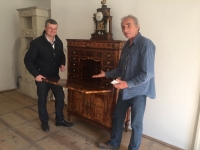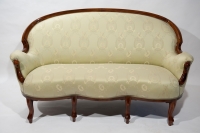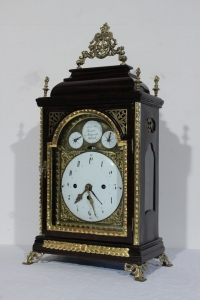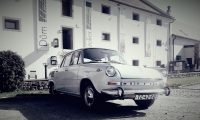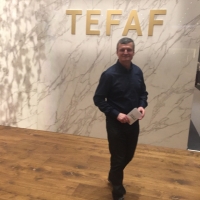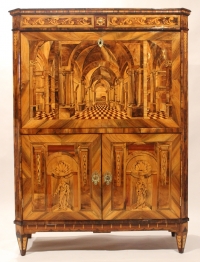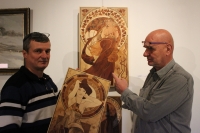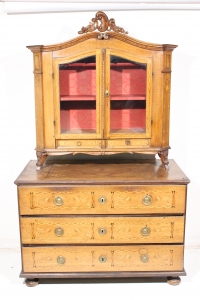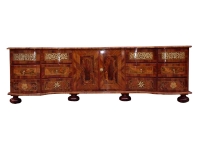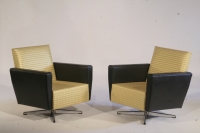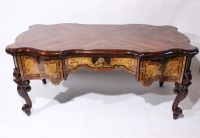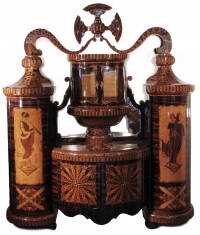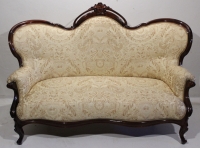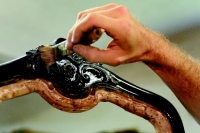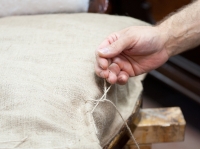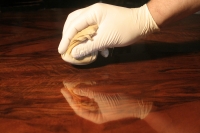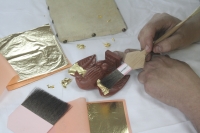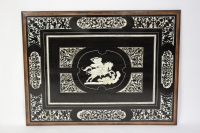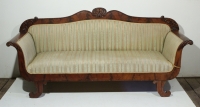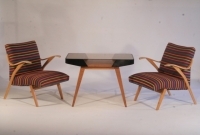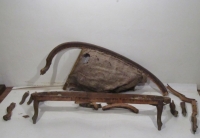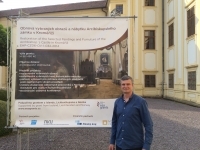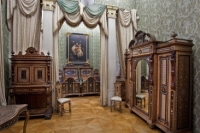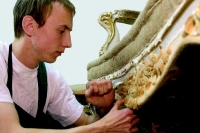Thursday, 17 May 2018 14:57
Sofa for Napoleon
Recently, during my wanderings in southern Europe, I bought an empire sofa with a stunning story. Fabulation or reality? Until that moment, I do not know myself, but the story was amazing at the time. I will leave the evaluation to you. As I said, I got an offer to buy a mahogany sofa for renovation. Its condition was not very representative, but I have already seen in my imagination its magnificent appearance when it will be completely renovated. When I heard her story, there was nothing to solve and the store was closed. The seller told me that he is friend of Pierre Humbert, a French architect who was in charge of reconstruction the Malmaison Chateau at the beginning of the 20th century, about 15 kilometers from Paris in the town of Rueil-Malmaison. The interiors went through renovations and as it happens, the unused property was sold or disposed…
Read more...
Thursday, 17 May 2018 14:36
Sculptor or furniture maker
Charles Cressent (1685–1768) was a sculptor and French furniture-maker and the two professions were linked together. He was likewise a sculptor, and among his plastic work is known to have been a bronze bust of Louis, the son of Philip II, Duke of Orléans, for whom Cressent had made one of the finest examples of French furniture of the 18th century the famous medaillier now in the Bibliothèque Nationale. As the second son of François Cressent, sculpteur du roi, and grandson of Charles Cressent, a furniture-maker of Amiens, who also became a sculptor, he inherited the tastes and aptitudes which were likely to make a finished designer and craftsman. Even more important perhaps was the fact that he was a pupil of André Charles Boulle. Cressent's bronze mounts were executed with a sharpness of finish and a grace and vigour of outline. His female figures…
Read more...
Thursday, 17 May 2018 12:26
Two opponents on stage - BIEDERMEIER versus BIEDERMEIER
We have two super-pieces in our shop. And now they will compete for your favor. Biedermeier vintage 1825 in walnut design with slightly younger Biedermeier vintage 1830 in cherry design. Both the two favorite of today's scenes are in the form as if they were just made. No wonder when we gave them such care. They were made from the finest materials of their time, including a stylish coat in the period fabric. The older rival in the walnut design gains charm with its black accessories and has 185 cm in total width. The younger rival, with a total width of 210 cm, turns out to be graceful in the bright cherry massif. Their forces are very balanced. And so I do not know which of the participants will gain more favor of admirers. They are currently on stage in the…
Read more...
Thursday, 17 May 2018 12:00
Georges Jacob (1739-1814)
He was one of the most important 18th-century furniture makers. His workshop produced neoclassical-style furniture with fine carving decorations, mostly in golden or mahogany designs. He became a respected supplier of the interiors of Queen Mary Antoinette, Louis XVIII, Charles X, Prince de Conde, and other dominions such as George IV. from England or Gustav III. from Sweden. Jacob was born in Cheny, Burgundy. Jacob was born in Chen in Burgundy. After his father's death in 1675, he left for study at the Poříčí workshop for Jean-Babiste Lerouge. He was received master 4 September 1765, pr esenting for his masterpiece a small chair of gilded wood, which survives. His creative talent began to promote in a neo-classicist concept. The furniture was very decorative with high utility value. The seating furniture was mostly comfortable upholstery. Jacob becomes a company partner, and his reputation grows rapidly and eventually spread beyond France. Its…
Read more...
Thursday, 17 May 2018 11:37
Currently We are buying marketing - not quality
Sometimes I think about the consumption of today's society. How else than in my field. As far as our work is concerned, I work with the historical furniture and its processing every day. When renovating always have to kind of identify with his creator, and very often we are surprised by the quality of their work, ingenuity and manufacturing mostly rarity of the pieces. When we are doing the healing process, even in the centuries of old pieces, always with great humility and respect for its creator. The dexterity and patience of the then-producers are always surprising us. It is no wonder, therefore, that we do not meet with anything other than high-quality historical furniture. But recently, I was forced by my little daughter to visit an "unnamed furniture house" and other similar shops with contemporary furniture. Not that I did not know about their production and the…
Read more...
Thursday, 03 May 2018 15:01
Thonet furniture at the top of the popularity of the 20th century
Thonet Michael (1796 - 1871) was the son of Franz Anton Thonet, a tanner from Boppard, near Koblence in the western part of Germany (then part of the revolutionary France).He taught a carpenter and established a workshop in the birthplace. Since 1819 he has been an independent carpenter.he married Anna Grahs, with whom he had seven sons and six daughters. Only four of the sons, however, survived early childhood. Michael was a visionary, and with his idea of modern living he tried to succeed in the area of bent furniture (especially beechwood). Thonet began trying to make furniture out of glued and bent wooden slats. His first success was theBoppard layerwood chair. Thonet's major breakthrough was his success in bending beechwood in hot water. This allowed him to design a brand new, elegant, light, durable and comfortable furniture of chic and curved shapes that strongly relied…
Read more...
Thursday, 03 May 2018 14:36
Table was the technical jewel of the 18th century
Again, one beautiful piece in our workshop is waiting for our care. But first of all something about its creator. David Roentgen (1743-1807) was born in Herrnhaagen, GermanyH|is father Abraham Roentgen, who had trained in London in the workshop of William Gomm, migrated to the Moravian settlement at Neuwied, near Coblenz, where he established a furniture factory. David learned his trade in his father's workshop, inherited the paternal business. Progressive designs and technically sophisticated elements in his furniture bring him great success and become one of the most famous furnituremakers of the 18th century. Famous throughout Europe for his technical solutions, secret drawers, all in a subtle neo-classical style. By that time, the name of the firm was well known, even in France. Since Paris was the style center of Europe, he opened a show-room, but his furniture was made in Neuwied. Roentgen becomes an important buissnisman. …
Read more...
Wednesday, 02 May 2018 15:31
The story of the imperial chairs from Schönbrunn
Very often I get the question "What have you renovated the most valuable or the most interesting" In the course of our work, there were really many renowned things with an interesting story. But on this question, I always tell the story of the imperial chairs that, in their wonderful state from the time of feudalism, have gone through Nazism to communism, where they have almost been destroyed. In order to describe this story, I must return to 1944 when the Nazis occupied Austria, thus ruling the Schönbrunn and Hofburg chateau, and, from the fear of allied troops, took the furniture from Vienna to the South Moravian castle in Uherčice. Count Antony Ottavian's Conte di Collalta e San Salvatore's convent was confiscated and the chateau in the border zone fell into the administration of the new Czechoslovak-Soviet army. The Vienna furniture dilapidated in the warehouse. Since 1947,…
Read more...
Wednesday, 02 May 2018 15:04
Treasure - waiting for his rediscovery for centuries
Like a little boy, I've always dreamed about adventure, the search for treasures, and everything that was covered with some mystery. Even more when it was with some historical subtext. Perhaps that is why I am currently deal with the restoration of historical objects by revealing their original beauty. In our country, discoveries of lost history are becoming increasingly uncommon, and if we want to find some quality antiques, we have to go beyond the borders. At the end of the summer, I was inspired by the atmosphere of the summer, with its history, in southern France. Experiences from sightseeing tours such as the Avignon fortress or the Notre Dame de Sénanque monastery with the scent of lavender are unforgettable, but it always makes me more drawn into the stone-built villages. On my journeys, I found myself in the mountain town of Collobrières, which fascinated me, and in…
Read more...
Wednesday, 02 May 2018 14:48
Tradition is commitment
In the 1990s, in a newly acquired democracy, I decided to do business like many others, and so I became a businessman. When I founded a firm, I did not even think that it should be named differently than me. Simply Fiala - restoration. However, at that time, I did not know how big a commitment it would be. Of course, I knew that I was follow up history of our family. Already in 1907 my great-grandfather Josef Fiala restored wall paintings in St. Michael's Cathedral on Old Town Square. His whole life he has intensively devoted to his own creation and restoration. He raised two sons who led to painting and they led their children to love art. The fact is, I started to do business. It was not always as simple as any business. Nevertheless, I could never allow myself to do an imperfect job and dishonor…
Read more...
Friday, 09 March 2018 15:07
Chairs "PANTON" - the most famous design of the 20th century
Verner Panton (1926 –1998) is considered one of Denmark's most influential 20th-century furniture and interior designers. During his career, he created innovative and futuristic designs in a variety of materials, especially plastics, and in vibrant and exotic colors. He designed fabric design, lighting, but mainly seating furniture such as the "Heart Cone" or "Panton" chair, which has become perhaps the most famous 20th century chair Panton designed for Vitra in 1967 and is so popular that he is still producing today. Panton was an experienced artist in Odense, next, he studied architecture at the Royal Danish Academy of Art in Copenhagen, graduating in 1951. During the first two years of his career, he worked at the architectural practice of Arne Jacobsen, another Danish architect and furniture designer. In 1955 he started his own design and architectural office. He became well known for his innovative architectural proposals for furniture…
Read more...
Friday, 09 March 2018 14:48
Housing with antiques or in modern style
My profession will certainly reveal my choice. And it is true that I almost always meet people of similar focus. In my proposals of interior design, sometimes I get the assignment to equip living, or just add antiques combined with modern and purposeful furniture. This work is, of course, much more complicated than unpacking, folding or installing the interior in some historical style as a whole. Selecting a suitable style for a given property is a routine based on some experience. But the combination of old and modern ... so it is about improvisation, sense, taste and also the imagination of both supplier and user. It's not quite simple, because the past and the present has no rules and the views can be very different. I am glad when the customer let me have an advice because the selection and composition of these two different styles and origins can…
Read more...
Friday, 09 March 2018 14:33
Auction record in a new coat
Dušan Samuel Jurkovič known as a peculiar architect, who designed buildings mostly in folk concept. As perhaps the most famous Libušín and Maměnka in Pustevny from 1897. The roots of Jurkovič's direction in working with folk forms can be found in family background when mother was an expert of folk art and father was a Slovak patriot. From 1884 to 1889 he studied architecture at the Industrial School in Vienna. Creative realization and personal style was acquired with Bully builders in Martin and then at Urbánka in Vsetín. In his work we can perceive the Art Nouveau popular in the time, enriched with the principles of the Biedermeier with the influence of Wiener Werkstätte in Vienna. However, the most prominent in his work is traditional folk, Slovak-Hungarian architecture. Although Jurkovič was the architect of the buildings and he had realized many important construction projects, he also devoted himself to interior…
Read more...
Friday, 09 March 2018 13:39
Architect - more famous today than in his time
In our restoration studio, furniture by architect Jindřich Halabala for renovation appears quite often. I do not wonder this fact at all. After all, the production from the 20th to 30th years of the Brno Arts and crafts industries was timeless, modern and of high utility value. Jindřich Halabala (1903 - 1978) trained in his father's workshop in Moravian Koryčany and then studied at a vocational school in Valašské Meziříčí and with professor Janák at the School of Applied Arts in Prague. After graduating in 1928, he joined the UP races, where he played several roles. In addition to the shop manager, he was responsible for the composition of the production assortment and also desingned the furniture. After two years, he became the chief architect and he also promoted the entire company that did not have competition in her field. UP races have become a progressive enterprise, whether…
Read more...
Friday, 09 March 2018 12:30
Josef Fiala - Old School Painter
Slovutný mistře! Zvěděl jsem v zařezanosti své oklikou a pozdě o zakulacené řadě dnů žití Vašeho. Blahopřeji Vám k tomu velmi vysokému stupni umění, kterého jste tak svéráznou horskou cestou dosáhl a přeji mnohá šťastná léta ve zdraví a na vrcholu V úctě srdečné Vám i milostivé paní provždy oddaný Ak. Malíř Franta Kaván t.č. Libeň 117 So many of the extant letter painter František Kavan addressed to Josef Fiala on his jubilee. Painter, portraitist, figural and landscape painter Josef Fiala was born July 31, 1882 in Prague Košíře to the family Vaclav Fiala merchant with flour. Both parents were from rural. He inherited a love for nature and the country life. Since childhood he was an enthusiastic draftsman, but he did not find at his parents so much enthusiasm for his painting hobby. After viewing biography personally drawn up by the painter himself in 1911, we…
Read more...
Friday, 30 June 2017 11:32
Investing in history and art is permanent
Investing in art and antiques has always been a good investment. Even under the past regime there were a lot of "collectors" - investors, and high-quality antiques were narrow-profile goods just like everyone at that time. However, after the revolution, this business grew into great proportions, and a lot of good-quality goods came at the market at fairly low prices, which were also exported abroad. This market has stabilized over time and has started to cope with foreign prices. Exports have gradually stabilized and even antiques have begun to import back to Czech republic. Since the economic crisis broke out in 2008, the trade began to stagnate. Except mainly in fine arts, when the quality assortment was always sold at high prices, and with more common antiques, prices were significantly reduced. We thought that this was only temporary and that prices would quickly return to…
Read more...
Friday, 30 June 2017 11:08
Nature is the greatest artist
I have been working on art of utility and art for a many years. We can admire gorgeous art or less good. The spectator can evaluate, praise and criticize. Mostly, we perceive art as the creation of a man who has a little talent or expresses his conception of this world. But in essence it is always the nature that is the greatest inspiration. For most of the time, artists have been interpreting the meaning of the nature and products of this world. Therefore, I can boldly say that nature is the greatest artist. Nature, which will always surprise us, and is able to inspire us again and again with its beauty. The nature that created her art beauties long ago and long before we came here and before we gave art the name of art. I'm very glad to be able to organize…
Read more...
Friday, 30 June 2017 09:51
Is it a good investment to buy a piece from a novice artist?
This is often a question. In general, I have to say that investing in art is always a good investment, but the question is how much or how fast the price of an artifact will rise. If you decide to invest in art, you can go in two ways. You go by way of security and invest in a partially-renowned author who has already set the market price and will expect his price to grow further, but you are currently buying it at its peak, for example at an auction at a merchant who definitely does not offer the work under price and so on. You can take more risks and invest in the artist (or in the purchase of the image), which is certainly not renowned and whose glory is still awaited. This investment is, of course, uncertain, but it can have a great…
Read more...
Friday, 30 June 2017 09:33
How to avoid rogue travers
At a time when we live, fraudulent behavior is becoming a standard. No one is surprised that in art every fifth picture is fake, that you are not sure at all in the antiques that the piece you offer is somehow altered, obliterated or even stylistically altered. If one forgets that the unethical behavior in society is quite common and no one is surprised that the very lowest representatives of our state are behaving like that, we should face these current behaviors! I try to consolidate the brand of our studio, which carries my name with solidity and the word has some weight. When i say something, so that's true. For many years, I've been trying to do it, and I see it as an award and our advantage.I like the trust of our customers. Although you always know what you…
Read more...
Friday, 30 June 2017 09:13
Collector and his world
I'm lucky to have a profession, which surround me a bunch of people with similar interests. They are lovers of old times, admirers of art and collectors of anything. Whatever the artifacts in their viewfinder, they have one thing in common. It's a "collector's passion". From my point of view I have to say that whoever does not have it, is a little depressed. The first weekend of May we organized the veterans' meeting for the seventh time. Every year, the participation and the prestige of this event increase. Over 120 cars were attended this year and more than 1,200 spectators arrived. When it meets so many people with the same interest, it is an inspiring and great atmosphere. There is always something to admire and desire. Enthusiasm of collectors and re-inventors into their work is charming. The exhibition of strollers and their development over the…
Read more...
Thursday, 29 June 2017 14:07
Keep an eye on legacy of our ancestors
František Palacký's secretary is back home again. After completing renovations we handed back the secretary to the descendant Václav Machacek Reiger at his Maleč Chateau. This piece was already one of the last, which was missing in the upcoming exposition of František Palacký's office, which should be opened to the public at the beginning of next year. I am very glad that we can participate in the restoration of interesting artifacts, and I appreciate that we can be part of such projects as the exposition of the most prominent figures of the national revival movement - František Palacký and František Ladislav Rieger. It is necessary to remind our past. With the motto "Appreciate the legacy of our ancestors" David Fiala
Read more...
Tuesday, 27 June 2017 14:00
... and what can you fix?
With a smile on my face, I answer that everything can be repaired, but it depends on the effort and the financial burden of the customer, it goes hand in hand. Of course, the applicants always receive information or reasoning on the extent to which it is right to invest from a commercial point of view. Not always the price of renovation is decisive. Very often, we are talking to customers about the investment, given the state of the matter, with the prospect that buyers can buy a similar thing after renovation at a lower price. Finance is not important many times, because relation to the matter can be more valuable, such as an inheritance, or a memory or nostalgia. Our reason why we went into renovating an almost unrenewable piece was somewhat simpler. We wanted to answer the question asked (... what you can…
Read more...
Tuesday, 27 June 2017 12:41
Baroque watch - again nice piece for sale
Interesting pieces appear on the market less and less, but from time to time they appear. We have recently accepted a collection of antiques from the inheritance. Occasionally, the customer offers a part or item for sale to pay for the renovation costs. We are glad that our antique range will often enrich interesting pieces just like in this case. For new owner awaits a beautiful Baroque clock from 1750 - 1760. The clock machine is anchor, quarter, drums - two-tone. The clock wardrobe is made of solid mahogany with gilded elements and brass applications. Overall dimensions are 60 cm high, 30 cm wide. Both the machine and the clock wardrobe have undergone a complete renovation, they are provided with a warranty and a certificate of authenticity. If you are looking for a high quality antique, you have the opportunity to become the owner. …
Read more...
Tuesday, 27 June 2017 11:51
... and then that the time can not be stopped
In my journeys on antique reviews, I traveled through many regions, picturesque and forgotten places of our beautiful country. I recently visited Tachov, where I was asked to review some of the historic properties. Then, during coffee and polite discussions, we have come to my hobby in old cars. The young man, who was also present at the same time, said: "And what about the grandfather´s MB car that we have in the garage ..." In the following story, I learned that in 1969, also in my year of birth, ancestor of my hosts bought the already mentioned Škoda 1000 MB car, but almost did not drive with it. And for the past 15 years, no one has ever started him. My curiosity was endless, and I did not even have to persuaded them so long. When I opened the garage, the passion of the…
Read more...
Tuesday, 27 June 2017 11:28
TEFAF - the world's largest art and antiques fair
I often answer questions about the antique market. What is his development, whether it is appropriate to invest in art, what kind of antique, or so, can be, and so on. I try to answer objectively at that time and situation. If I have to summarize the development of the past 10 years, I have to orientate myself in the situation in the current market not only in our Czech basin, but also in the world market. So I went to the biggest TEFAF world trade fair in Maastricht, Netherlands. Soon it will be almost ten years when the antiques and art shops have been greatly affected by the economic crisis. Except for high-quality art, prices have fallen sharply. The commodity market stagnated and grew very slowly. At present, when we see economic growth, the antique business has also revived in the market and, in…
Read more...
Wednesday, 10 May 2017 10:19
The secretary, on which František Palacký wrote the Memory of the nation
In my work I met interesting historical objects and their current owners, who are the descendants of the original owners and so on .... The fates of our ancestors or their antiquities that have been part of them are many times very interesting. In the summer, a descendant of František Palacký turned to me, who is, among other things, a friend of mine since my youth years, to take on one more antiquity, as I have done several times in the past years. At the Maleč Chateau, where František Ladislav Rieger and František Palacký worked, I regularly drive and our work helps with the building of a future exposition. This time we received an extra piece - a renaissance secretary of extraordinary processing. Intarsie stacked into architectural patterns with a detailed perspective and detailed figures. Just a splendor. Another surprise for us was the arrangement…
Read more...
Tuesday, 10 January 2017 11:14
Miner - craftsman or artist?
Occasionally we hear "that someone has the wrong profession". Mr. Louis turned to me with offer or rather request if we were not interested in exhibiting his works, because he is interested in marquetry. This is nothing unusual, but when I was on a visit to find out how he made marquetry, I was surprised and can say, perhaps even excited. Marquetry or rather parts, are mostly glued to the base material so as to form compact solid surface. But Mr. Louis marquetry, the individual parts, precision hand-carved and pasted them only at the edges to each other, exactly adjacent, in the thickness of 1 mm. This means that the entire pattern is strong only one millimeter and you can look from the reverse side. The beauty of a wooden image then amplifies topic of Mucha. Accuracy and selection of individual veneers, using various knots and drawings…
Read more...
Monday, 09 January 2017 14:58
Appreciate the old furniture, will not be!!!
Sometimes I use this slogan as well as several others. It is true that antiques that are offered for sale, is fast running out, and the quality one has been come across very rarely. For that reason the quality stuff immediately sold and many times even the price does not matter. Restoration is our daily work, and so we see how the owners appreciate their antiques and increasingly fewer of them giving away and providing is for sale. But occasionally we find some interesting piece that appears. For example, we have taken to selling a beautiful neoclassical commode with extension that is beautifully inlaid with fruit trees. Besides, it is beautiful, it is also authentic in its original condition without any restoration and secondary repair. Is remarkable that the antique from the second half of the 18th century is maintained in…
Read more...
Monday, 09 January 2017 12:48
Lost rose Rosenbergs
Very often we get questions, what interesting antiques we restored and which had a story, or to whom interesting personalities belonged to. Not so long ago, when we were contacted by known antique dealer that she has received a very interesting baroque dresser. At the first sight, it was clear that it was an exceptional piece. Baroque artisans showcase the full range of their skills: inlay of precious woods, marquetry of pewter and bones and painting. Moreover, the image of each manor at the forefront of drawers revealed, it is a part of representative furniture ... maybe aristocratic family? Commode was exceptional size, but in very poor condition. Actually, it was only a torso. The best preserved was the front wall with twelve drawers and double-wing door in the middle. Original upper plate is not retained at all, the entire bottom and lower back was heavily damaged by dry…
Read more...
Monday, 09 January 2017 12:39
RETRO – current phenomenon
Design 60s-80s is now trendy. In the field of renovation of antique furniture we have been active for 25 years and during those years I note a significant shift in sales of antiques. In the 90s from Czech republic was exported antique furniture to foreign countries, it was predictable, after all, the inability to trade in the past, and large economic disparities to facilitate this. At the beginning of the 21st century the business started to gradually change, historic furniture again began to import mostly from France. In recent times we have seen increased interest of foreign clients of furniture from the Czechoslovak production from the 60s-80s of the 20th century. Traders began re-export furniture from Czech republic that is beyond became very popular. Even though we lived in normalization and it was the industrial production, it was used quality materials. Architects, who designed the furniture,…
Read more...
Tuesday, 15 November 2016 14:32
Baroque desk exceptional quality
In our work, we meet a lot of interesting antiques, furniture, as well as their special destiny. Earlier this year, I spoke to an older lady - a widow who has after her husband,also furniture restorer, tools, materials and unfinished furniture. Her husband left his workshop and this world more than 20 years ago and since then in the workshop was no one. A visit to the kingdom of restorer for me was shrouded in mystery and with some excitement, I walked into a forgotten world. I felt like a kid in a toy store. In the corner of the workshop stood a huge baroque table. In terrible condition, disassembled for parts, needed reconstruction but its shapes, rich inlay revealed that this is something extraordinary. However after the inspection, I decided that the whole table is due to improper storage and high humidity in a very degraded state, and…
Read more...
Tuesday, 15 November 2016 14:25
Searching for the architect of a unique Art Deco furniture
Recently we completed the renovation of an unusually interesting set of modernist furniture. We professionally do restoration for a quarter of a century, but with such special furniture we haven't met yet. The piece is unique not only for unusual combinations of decorative elements and overall opulence, but also precise, demanding and in many respects unusual craftsmanship. In addition to the total renovation our current owner asked us to finding some information about the origin and production of architectural or desing of their creators. We had information only from the owner, who bought a villa in Kosice also with mentioned furniture that was made to order. Upon further search of information, we found that the owner of the villa Hungarian Jewish during the war became victims of the holocaust and the house, like many other splendid buildings changed owner, according to the regime. Owners have changed here. Furniture was…
Read more...
Tuesday, 15 November 2016 14:14
Antique in a new outfit
Sofa is in the style of Louis Philippe, which served our ancestors since 1860. Now again it´s shining as the time of its inception. Sofa has passed a complete renovation of structural wood elements and new original upholstery techniques using only traditional materials like horsehair, hemp ropes and straps. The substance was also chosen with respect to the historical style. Patterns have leafy motifs same as on carvings on sofe. We looking for a new owner for this beautiful sofa so the history could continue.
Read more...
Thursday, 20 October 2016 15:19
Step by step
Restorer is craftsman, artist, and a little bit too unconventional. It is very interesting cocktail. And what do we imagine that happening in the workshop of the restorer? Lets look. Restorer takes a pictures every each piece, whether it is a dresser, sofa, picture, or watches. Then he sits down and draws up a description of a restoration plan. And then is a crafts phase. Imagine, that we renovate a commode from the eighteenth century with a rich inlay. First, the whole commode dismantled into individual parts. Cleaned from the original lacquer, binding and other dirts. It is likely that some components are missing, or they will not be able to repair. In this case, our restorer makes a new part faithfully similar to the missing, but he must choose the old wood with similar qualities. So we made the refunds and that its have to be glued to their…
Read more...
Monday, 12 September 2016 10:43
Take a look under the hands of restorer: 3.part Upholstery
Upholstery of the seating furniture began to massively used in the days of the late renaissance and early baroque period, when it started to pay more attention to the convenience and comfort of living, mainly in the higher layers and burgesses. Initially, the furniture is softened by using various natural materials, and how increased demands of comfort, and it began to emerge the various processes used in the production of upholstery property. The most common method was the use of metal springs that were detached in one unit and this layer followed the anatomy of the furniture body and thus become very convenient. This part was a basis for further layers, such as straw or African grass, later very durable horsehair, which is in very good condition until today in preserved furniture. Upholstery is obviously the most delicate thing for restore. Original upholstery doesn't retains often and in recent…
Read more...
Friday, 02 September 2016 10:56
Take a look under the hands of restorer: 2.part The French polish
The highlight of the work is to create a furniture by french polishes. French polish gives the wood a new dimension, highlights its beauty, depth and subtlety drawings and revives its color. It is still valuable and optically noblest way, how finish modifying of wood. Shellac is a resin secreted by the female lac bug (Kerria lacca), on trees in the forests of Thailand. Use this secretions protect their larvae from the adverse effects of the environment. Shellac was imported into Europe in the late 17th century and used to paint especially valuable pieces of furniture veneered or inlaid. The "period of widespread introduction" would seem to be in the 18th and 19th centuries. Because the French polish can not be applied mechanically and the process was very labour intensive, so many manufacturers abandoned the technique around 1930. Today, the French polish is used almost exclusively in…
Read more...
Thursday, 18 August 2016 14:01
Take a look under the hands of restorer – 1 part Gilding
The term gilding covers a number of decorative techniques for applying fine gold leaf or powder to solid surfaces such as wood, stone, or metal to give a thin coating of gold. Gilding has been known since antiquity, mentioned in the Old Testament and in Herodotus. Traditionally, the purpose of gilding is to achieve decorative and luxurious-looking surface, which better resists corrosion and weathering. Since ancient times cult and ritual objects are gilded. Mechanical gilding includes all the operations in which gold leaf is prepared, and the processes to mechanically attach the gold onto surfaces. Polished iron, steel and other metals are gilded mechanically by applying gold leaf to the metallic surface at a temperature just under red-hot, pressing the leaf on with a burnisher, then reheating when additional leaf may be laid on. Gold leaf is often thinner than standard paper today, and when held to the light…
Read more...
Wednesday, 27 July 2016 15:22
Furniture Venetian masters from the 17th century in Kroměříž
Master piece of Venetian masters of the 17th century. Master piece of Venetian masters of the 17th century. The construction of the massive ebony and inlaid with ivory, which is engraved engraving in animal scenes. The furniture is installed at the Archbishop's palace in Kroměříž. Furniture was probably make by Francesco Morosini in Venice in the 17th century and Archbishop of Olomouc Theodor Kohn bought it in the 19th century and took on Kromeříž castle. Furniture has central european expression, but it is evident the influence of the orient. It was common in Venice. The entire ensemble is perceived as unique with the original concept of the author. Archbishopric of Olomouc in the middle of last year contacted us, in case of the restoration of this unique collection of furniture come from Venice. For our studio it was a challenge and ten month of interesting…
Read more...
Tuesday, 12 July 2016 14:10
How to choose a quality antiques
New standards in arranging Antibes The society continues to evolve and, with it, their needs and standards. And not otherwise in our activities. Our goal is to continually improve and expand services in the areas of our activities, including restoration. Lately we are seeing increasing demand for advice when buying antiques. Although you have a clear awareness of the antiques that you want to buy, but it is not necessarily advantageous as you imagine. It can cause a number of reasons. A given artifact could be overpriced due to its historical value or it could be improved only for eye for profitably sold. With this fact we see very often - they are unreliable practices of traders. Although the piece condition seemingly good or perhaps renovated, the subsequent costs of renovation are much greater than the things greatly neglected. Therefore, we focused on searching for quality antiques with their true…
Read more...
Wednesday, 22 June 2016 11:52
Antiquities or just old furniture
Very often our customer ask us "And this is already an antique?" I ask myself same question. "What is really antique?“ „ The historical furniture measurable with his age? " It's an antique what comes after the Baroque, Biedermeier, Art Nouveau and Art-deco? Not so long ago, I thought that in the prewar period, it stops and can no longer speak about antiquities. Over time and based on the requirements of our customers. "Oh, that we had at home" Very often I hear from enthusiastic faces of visitors, and this may not be historical furniture from our ancestors, but any furniture which bind childhood memories of living with grandmother or our children's rooms. Therefore I believe that the antique beginning to be antiques at a time when beginning to provoke nostalgic memories,…
Read more...
Wednesday, 22 June 2016 10:12
... like a phoenix from the ashes
The first contact with the customer very often we asked, "And it's worth it to renovate?" Restorer can not give completely unambiguous answer. If there is already an antique in a very degraded condition and restoration expenditures are already to a given piece of very high, so from a business perspective renovation financially probably already too disadvantageous. But there's the other side, preservation of historical artifacts. Things that lived here before us for centuries. If we do not save it by renovations, it will end up in the dustbin of history. Recently customer turned to us and he brought torso sofas in the style of Louis Philippe, that was unidentified. After inspection and restoration survey, we observed that the renovations is not worth it financially. So we have offered him that he can buy similar sofa cheaply. Customer response was unequivocal. "It's the only thing that was found…
Read more...
Wednesday, 22 June 2016 10:02
Conference - Restoration of cultural heritage Archbishop chateau in Kroměříž financed by Norwegian funds
David Fiala, who represented a restoration studio, which restored part of the furniture - furniture equipment, lectured on the restoration, techniques and pitfalls of this work. The conference was attended by restorers and representatives of investors from Norway. The lecture was simultaneously translated into English. "Ladies and gentlemen, Allow me to introduce myself and introduce company that I represent. My name is David Fiala and I am the founder of the same name restoration studio. Atelier Fiala deal with restoration since 1991 in various forms of community. We are honored that we were able to participate in the restoration of such valuable cultural heritage. " In the middle of last year we stood before the responsible task of restoration. Renovation of 28 items of furniture from the 19th, 18th and 17th centuries. Shortly before today's conference, we completed the entire set, this work lasted ten months. The work was very…
Read more...
Wednesday, 22 June 2016 09:53
About the restoration of the bedrooms of the archbishop's palace in Kroměříž
We are honored that we were able to participate in the restoration of such valuable cultural heritage, as we see here at the Archbishop's castle. Each work of this type is a challenge for us and are pleased that we can contribute to saving historical artifacts as testimony of history. All the more so if it is so unique furniture, such as bedroom sets, which in the 19th century Theodor Khon bought by Italian masters. Work on this file is absolutely fabulous. Whenever we stand in front of such a piece of furniture, we work with great humility and respect for the craft of the time. Only an awareness of what equipment and with what accuracy and precision our ancestors once worked. Despite the fact that today we have the technology and new materials, it is essential for us always use original techniques using traditional materials. For intarsia in this…
Read more...
Wednesday, 22 June 2016 09:47
A craftsman or an artist?
If we look at restorer as an artist - we're right. If we look at restorer as a skilled craftsman ... we're right too. This profession combines artistic sensibility, knowledge of historical styles and craft skills, like hardly any other. Really experienced restorer was blessed with a considerable sense of beauty and reverence not only a noble material, with which works, but especially to the author. After all, he must empathize with that thing and intention. However how much is changing person's needs and desires for the last, say, two hundred years, the materials and processes for the renovation remain the same. For several centuries, gloss on antique furniture is formed by French polish. French polish gives grandeur aristocratic and middle class equipments, but the origin of the French polishes have not so noble. Shellac is a resin secreted by the female lac bug, on trees in the forests of…
Read more...





